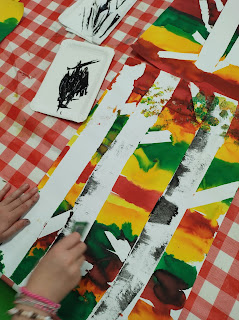made by students of grade 4
You need per student:- 1 sheet white drawing paper
- 1 sheet colored construction paper
- 1 sheet colored construction paper from which you cut 7 cm
- 1 sheet blue construction paper
- leftovers of colored paper
- glue
- scissors
- black marker
Who is Matisse?
Matisse (1869 –1954) was a French artist, known for both his use of colour and his fluid and original draughtsmanship. He was primarily known as a painter.
Matisse didn't care if stones were blue, he just chose the colors he liked. Some people thought is art was very ugly: someone who paints blue faces and green noses is a fool and Matisse was called 'Fauve', which means: wild. This is how the word Fauvism came into being for this art movement, art with bold colors.
After a surgery Matisse spent the rest of his life in a wheelchair. He wasn't able to paint anymore, but could still paint with his scissors.
View various artworks of Matisse.
Then few the artwork Oasis. What stands out?
- no straigh lines
- organic shapes
- bright colors
- What is an oasis and why is this artwork called so?
How to make it
Step 1
Take the two colored sheets: a whole one and one with 7 cm cut off. Paste the smaller sheet on the large one. The strip at the bottom is the table for the fishbowl.
Step 2
Cut Matisse shapes and glue them on the small sheet. Let them fall of the sheet and cut away the outer pieces.
Step 3
Fold a white sheet in half on the long side and cut out a fishbowl. The center line of the bowl is the fold of the sheet. Trace around the bowl with a thick black marker.
Step 4
Cut 'water' out of the blue sheet, slightly smaller than the bowl. Paste it in the bowl. Paste the bowl on the colored sheet with organic shapes.
Step 5
Cut two or three fishes and some water plants and paste them in the bowl.
Elements of art: shape, color.























